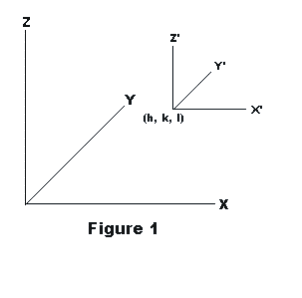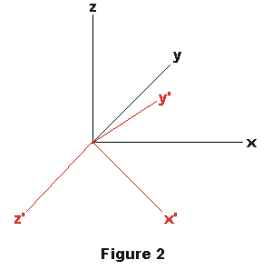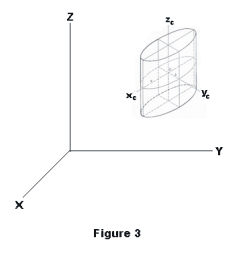
Website owner: James Miller
TRANSFORMATION OF COORDINATES
To transform an equation of a surface from an old system of rectangular coordinates (x, y, z) to a new system of rectangular coordinates (x', y', z'), substitute for each old variable in the equation of the surface its expression in terms of the new variables.
Translation of coordinate system. Let the origin of the new x'-y'-z' system be at point (h, k, l) of the old x-y-z system with the axes of the new system parallel to the corresponding axes of the old system. Then

x = x' + h
y = y' + k
z = z' + l
See Figure 1.

Rotation of the axes about the origin. Let the origin of the new x'-y'-z' system be coincident with the origin of the old system and let λ1, μ1, ν1 be the direction cosines of the x' axis, λ2, μ2, ν2 be the direction cosines of the y' axis, λ3, μ3, ν3 be the direction cosines of the z' axis.
Then
x = λ1x' + λ2y' + λ3z'
1) y = μ1x' + μ2y' + μ3z'
z = ν1x' + ν2y' + ν3z'
x' = λ1x + μ1y + ν1z
2) y' = λ2x + μ2y + ν2z
z' = λ3x + μ3y + ν3z
We can write these equations in matrix form as


where the matrices are called rotation matrices. Multiplication by a rotation matrix transforms the coordinates of a point from one system to another system.
Note. Equation 1) is best understood in vector terms as a change of basis where 1) is equivalent to

the vectors


representing orthogonal, unit basis vectors.
Equations relating the coordinates of the original and canonical coordinate systems of a quadric surface. Let x, y and z be the coordinates of a point P with respect to the original X-Y-Z coordinate system and xc, yc and zc be the coordinates of the point with respect to the canonical Xc-Yc-Zc coordinate system. See figure 3. Let the origin of the canonical Xc-Yc-Zc system be located at (x0, y0, z0) and let λ1, μ1, ν1 be the direction cosines of the xc axis, λ2, μ2, ν2 be the direction cosines of the yc axis, λ3, μ3, ν3 be the direction cosines of the zc axis. Then the relationship between the coordinates x, y, and z and xc, yc and zc is given by the following equations:

and
